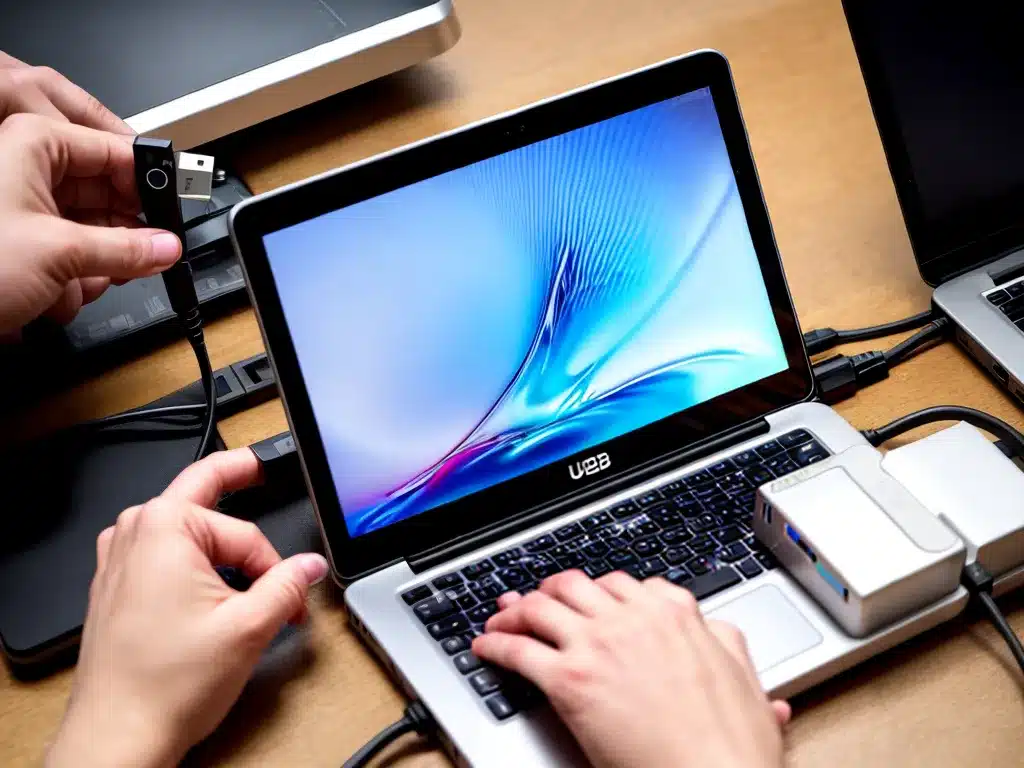
USB ports are a convenient way to connect devices to your computer. However, sometimes USB ports can stop working properly. Here are some tips on how to fix non-functioning USB ports.
Troubleshoot Software Issues First
Before digging into hardware issues, first troubleshoot any potential software problems:
-
Restart your computer. Restarting your PC resets connections and often resolves minor software glitches.
-
Update USB drivers. Outdated USB drivers can cause connection issues. Go to Device Manager, find your USB device, right click it and select “Update driver”.
-
Uninstall USB controllers. In Device Manager, expand “Universal Serial Bus controllers”, right click each item, and select “Uninstall device”. Then restart your computer and Windows will reinstall the USB controllers.
-
Disable USB selective suspend. This setting can sometimes prevent USB devices from working properly. Go to Control Panel > Hardware and Sound > Power Options > Change plan settings > Change advanced power settings > USB settings > USB selective suspend setting, and set it to Disabled.
-
Unplug devices. Try unplugging all USB devices except for your keyboard and mouse, and see if the ports start working again.
Check for Physical Damage
Inspect the USB ports and connectors for any physical damage:
-
Examine the USB ports on your computer for bent/broken pins, cracks, loose connections, or other obvious defects. Use a flashlight and magnifying glass if needed.
-
Check the USB cable and connector for damage, like cuts, frays, or bent pins. Try connecting the device with a different USB cable if available.
-
Verify the USB device itself does not have broken pins or defects in the port.
-
Wiggle cables while connected to see if there are any loose connections.
-
Try connecting the device into another USB port to isolate the issue.
Update BIOS/Firmware
Outdated system BIOS/firmware can sometimes lead to USB issues. Go to your manufacturer’s website and search for a BIOS update specific to your computer model. Follow the instructions to update your BIOS to the latest version.
Check Power Supply
USB ports may stop functioning if they aren’t receiving sufficient power.
-
If the USB device requires extra power, connect it to a powered USB hub instead of directly to the computer.
-
For desktop PCs, check that the USB port connections inside the case are secure.
-
Laptop USB connections can’t be accessed, but you can try a USB port tester to measure voltage and amperage.
-
As a last resort, use a multimeter to test voltage directly on desktop computer USB port pinouts. Pins 1 & 4 should read around 5V.
Reinstall USB Controllers
If USB controllers have become corrupted, you may need to reinstall them:
-
Open Device Manager and expand “Universal Serial Bus controllers”.
-
Right click each device and select “Uninstall device”.
-
Important: Also check the box to “Delete the driver software for this device”.
-
Restart your PC and Windows will automatically reinstall the USB controllers.
Enable USB Root Hubs
The USB root hubs coordinate all USB communication in Windows. If they are disabled for some reason, no USB devices will function.
-
Open Device Manager, expand “Universal Serial Bus controllers”.
-
If you see any devices labeled “Unknown device”, right click and select “Update driver”. This should re-enable the USB root hubs.
-
You can also try uninstalling each item under “Universal Serial Bus controllers”, restarting your PC, and letting Windows reinstall them from scratch.
Replace Hardware
If you have exhausted all other troubleshooting, the USB ports, cables, or devices themselves may need to be replaced:
-
For desktop PCs, open the case and check if all USB port connections are properly attached to the motherboard. Reseat connections or replace defective ports.
-
For laptops, USB ports can’t be easily replaced. You may need to take it into a repair shop if connections can’t be repaired.
-
Replace any damaged cables or devices. Test connectivity with multiple known good cables and devices to isolate the faulty component.
-
As a last resort, replace the motherboard if USB ports are defective and irreparable.
Following these steps should help identify and resolve any software or hardware issues causing your USB ports to not function correctly. If problems persist after exhausting all options, consider taking your computer into a repair shop for further troubleshooting.












